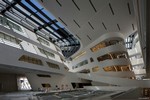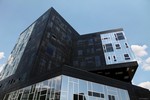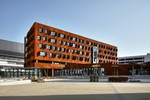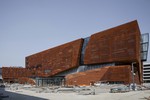The New WU Campus
University of the Future
Internationalism, innovation, diversity — the new Campus WU is the concrete realization of WU's vision for a modern university. The fundamental principles of the new architecture reflect the values and ideas we cherish at WU.
As a public institution, WU has lived up to its responsibility of building its new campus in an economical, ecological, and socially sustainable manner. WU's decision to locate the new campus in Vienna's second district will redefine this area and transform it into an educational hub. We have not only constructed new buildings, but in the process we have also given concrete realization to our ideas of what the university of the future should look like. The new campus is more than just a place for academic research and teaching and learning practical skills; it is also designed to create a new space for social, cultural, and political life.
The imposing Library & Learning Center (LC), designed by the Iraqi-British architect Zaha Hadid, is a testament to the central importance of research and teaching at WU. The Library & Learning Center is surrounded by five building complexes, including the Teaching Center, which houses most of WU's auditoriums. The Teaching Center is intended mainly for bachelor degree students, while the master degree programs are taught primarily in the individual Department buildings. The Executive Academy building is the home of continuing education and life-long learning programs. In this way, the various buildings and their functions reflect the three tiers of teaching and learning represented by the Bologna Process.
WU's Department-based organizational structure was also a contributing factor. In the past, the various Institutes that make up the Departments were scattered across different locations. Now they have been brought together in four Department buildings, which will make life much easier for both students and faculty.
These are not the only improvements the new campus has to offer: All rooms have natural light, and the auditoriums feature state-of-the-art teaching equipment, including digital whiteboards. There are 3,000 student workplaces, three times as many as in the old buildings in Vienna's ninth district. These workplaces are located not only in the dedicated self-study areas, but also in project rooms that can be booked by teaching staff and students alike. They cater to different needs by providing quiet spots for focused academic work as well as opportunities for work on group projects in communication-friendly study areas.
The top priority in planning the new campus was to create an environment for WU students and staff that is conducive to productive work and communication.
Not only the buildings themselves, but also the surrounding grounds offer plenty of opportunities for communication and meeting people. 55,000m² of Campus WU's total 100,000m² of floor and surface area is open, publicly accessible space. Fences or barriers would contradict our vision of an open campus.
Visitors and area residents are more than welcome at Campus WU. The campus offers not only food for thought, but also restaurants, cafés, and shops, all in a stimulating architectural environment.
As different as they may look, however, the buildings are all based on the same overall technical concept: the building infrastructure is standardized in terms of construction, energy supply, ventilation, and sanitary facilities. The entire campus has been designed in accordance with green building
principles. Much of the required energy is obtained using geothermal energy from groundwater.
Another key feature of Campus WU is barrier-free accessibility. All auditoriums are specially equipped for people with disabilities, all areas are designed to be wheelchair accessible, and the campus also features a tactile guidance system for the visually impaired.
We have not only made sure to comply with all the relevant legal guidelines in designing the new campus, but we have also drawn on experience gained from best practice examples. WU aims to play a pioneering role — in all respects.

![[WU Wien]](img/wu.jpg)
![[NOEG]](img/noeg_small.png)




